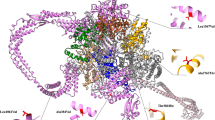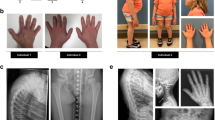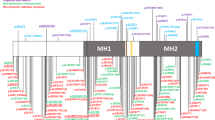Abstract
The brachyolmias constitute a clinically and genetically heterogeneous group of skeletal dysplasias characterized by a short trunk, scoliosis and mild short stature1. Here, we identify a locus for an autosomal dominant form of brachyolmia on chromosome 12q24.1–12q24.2. Among the genes in the genetic interval, we selected TRPV4, which encodes a calcium permeable cation channel of the transient receptor potential (TRP) vanilloid family, as a candidate gene because of its cartilage-selective gene expression pattern. In two families with the phenotype, we identified point mutations in TRPV4 that encoded R616Q and V620I substitutions, respectively. Patch clamp studies of transfected HEK cells showed that both mutations resulted in a dramatic gain of function characterized by increased constitutive activity and elevated channel activation by either mechano-stimulation or agonist stimulation by arachidonic acid or the TRPV4-specific agonist 4α-phorbol 12,13-didecanoate (4αPDD). This study thus defines a previously unknown mechanism, activation of a calcium-permeable TRP ion channel, in skeletal dysplasia pathogenesis.
This is a preview of subscription content, access via your institution
Access options
Subscribe to this journal
Receive 12 print issues and online access
$209.00 per year
only $17.42 per issue
Buy this article
- Purchase on Springer Link
- Instant access to full article PDF
Prices may be subject to local taxes which are calculated during checkout





Similar content being viewed by others
References
Shohat, M., Lachman, R., Gruber, H.E. & Rimoin, D.L. Brachyolmia: radiographic and genetic evidence of heterogeneity. Am. J. Med. Genet. 33, 209–219 (1989).
Kornak, U. & Mundlos, S. Genetic disorders of the skeleton: a developmental approach. Am. J. Hum. Genet. 73, 447–474 (2003).
Superti-Furga, A., Bonafe, L. & Rimoin, D.L. Molecular-pathogenetic classification of genetic disorders of the skeleton. Am. J. Med. Genet. 106, 282–293 (2001).
Horton, W.A., Langer, L.O., Collins, D.L. & Dwyer, C. Brachyolmia, recessive type (Hobaek): a clinical, radiographic, and histochemical study. Am. J. Med. Genet. 16, 201–211 (1983).
Toledo, S.P.A. et al. Recessively inherited, late onset spondylar dysplasia and peripheral corneal opacity with anomalies in urinary mucopolysaccharides: a possible error of chondroitin-6-sulfate synthesis. Am. J. Med. Genet. 2, 385–395 (1978).
Fontaine, G., Maroteaux, P., Farriaux, J.P. & Bosquet, M. Pure spondyloepiphyseal dysplasia or brachyolmia. Arch. Fr. Pediatr. 32, 493 (1975).
Gardner, J. & Beighton, P. Brachyolmia: an autosomal dominant form. Am. J. Med. Genet. 49, 308–312 (1994).
Funari, V.A. et al. Cartilage-selective genes identified in genome-scale analysis of non-cartilage and cartilage gene expression. BMC Genomics 8, 165–177 (2007).
Liedtke, W. et al. Vanilloid receptor–related osmotically activated channel (VR-OAC), a candidate vertebrate osmoreceptor. Cell 103, 525–535 (2000).
Nilius, B., Watanabe, H. & Vriens, J. The TRPV4 channel: structure-function relationship and promiscuous gating behaviour. Pflugers Arch. 446, 298–303 (2003).
Nilius, B., Owsianik, G., Voets, T. & Peters, J.A. Transient receptor potential cation channels in disease. Physiol. Rev. 87, 165–217 (2007).
Pedersen, S.F., Owsianik, G. & Nilius, B. TRP channels: an overview. Cell Calcium 38, 233–252 (2005).
Nilius, B., Vriens, J., Prenen, J., Droogmans, G. & Voets, T. TRPV4 calcium entry channel: a paradigm for gating diversity. Am. J. Physiol. Cell Physiol. 286, C195–C205 (2004).
Watanabe, H. et al. Anandamide and arachidonic acid use epoxyeicosatrienoic acids to activate TRPV4 channels. Nature 424, 434–438 (2003).
Watanabe, H. et al. Activation of TRPV4 channels (hVRL-2/mTRP12) by phorbol derivatives. J. Biol. Chem. 277, 13569–13577 (2002).
D'hoedt, D. et al. Stimulus-specific modulation of the cation channel TRPV4 by PACSIN 3. J. Biol. Chem. 283, 6272–6280 (2008).
Vriens, J., Owsianik, G., Janssens, A., Voets, T. & Nilius, B. Determinants of 4 alpha-phorbol sensitivity in transmembrane domains 3 and 4 of the cation channel TRPV4. J. Biol. Chem. 282, 12796–12803 (2007).
Watanabe, H. et al. Modulation of TRPV4 gating by intra- and extracellular Ca2+. Cell Calcium 33, 489–495 (2003).
Wang, Y. et al. OS-9 regulates the transit and polyubiquitination of TRPV4 in the endoplasmic reticulum. J. Biol. Chem. 282, 36561–36570 (2007); published online 11 October 2007.
Suzuki, M., Mizuno, A., Kodaira, K. & Imai, M. Impaired pressure sensation in mice lacking TRPV4. J. Biol. Chem. 278, 22664–22668 (2003).
Muramatsu, S. et al. Functional gene screening system identified TRPV4 as a regulator of chondrogenic differentiation. J. Biol. Chem. 282, 32158–32167 (2007).
Foster, J.W. et al. Campomelic dysplasia and autosomal sex reversal caused by mutations in an SRY-related gene. Nature 372, 525–530 (1994).
Chikuda, H. et al. Cyclic GMP-dependent protein kinase II is a molecular switch from proliferation to hypertrophic differentiation of chondrocytes. Genes Dev. 18, 2418–2429 (2004).
Becker, D., Blasé, C., Bereiter-Hahn, J. & Jendrach, M. TRPV4 exhibits a functional role in cell-volume regulation. J. Cell Sci. 118, 2435–2440 (2005).
Hunziker, E.B. Mechanism of longitudinal bone growth and its regulation by growth plate chondrocytes. Microsc. Res. Tech. 28, 505–519 (1994).
Olsen, B.R. et al. Genetic and epigenetic determinants of skeletal morphogenesis – role of cellular polarity and ciliary function in skeletal development and growth. Oral Biosci. Med. 2, 57–65 (2005).
Xiao, Z. et al. Cilia-like structures and polycystin-1 in osteoblasts/osteocytes and associated abnormalities in skeletogenesis and Runx2 expression. J. Biol. Chem. 281, 30884–30895 (2006).
Giamarchi, A. et al. The versatile nature of the calcium-permeable cation channel TRPP2. EMBO Rep. 7, 787–793 (2006).
Lange, K. et al. Mendel version 4.0: a complete package for the exact genetic analysis of discrete traits in pedigree and population data sets. Am. J. Hum. Genet. 69 (Suppl.), A1886 (2001).
Nilius, B., Prenen, J., Wissenbach, U., Bodding, M. & Droogmans, G. Differential activation of the volume-sensitive cation channel TRP12 (OTRPC4) and volume-regulated anion currents in HEK-293 cells. Pflügers Archiv. Eur. J. Phys. 443, 227–233 (2001).
Acknowledgements
This work was supported in part by grants from the National Institutes of Health (HD22657) and the Human Frontiers Science Program (HFSP Research Grant Ref. RGP 32/2004), the Belgian Federal Government, the Flemish Government, the Onderzoeksraad KU Leuven (GOA 2004/07, F.W.O. G.0136.00; F.W.O. G.0172.03, Interuniversity Poles of Attraction Program, Prime Ministers Office IUAP Nr.3P4/23, Excellentiefinanciering EF/95/010) to B.N. Microarray data were generated and analyses were performed within the University of California, Los Angeles DNA microarray facility. We thank the families for their active participation.
Author information
Authors and Affiliations
Contributions
M.J.R., J.P., T.V., B.N., S.F.N. and D.H.C. designed the experiments. M.J.R., J.P., G.O., A.J., B.M. and V.A.F. carried out the experiments. T.L.F., R.S.L., W.R.W., S.R., R.Q., A.V., S.I., T.N. and D.L.R. ascertained and diagnosed the subjects. M.J.R., B.N. and D.H.C. wrote the manuscript.
Corresponding author
Supplementary information
Supplementary Text and Figures
Supplementary Figures 1–4, Supplementary Tables 1 and 2 (PDF 305 kb)
Rights and permissions
About this article
Cite this article
Rock, M., Prenen, J., Funari, V. et al. Gain-of-function mutations in TRPV4 cause autosomal dominant brachyolmia. Nat Genet 40, 999–1003 (2008). https://doi.org/10.1038/ng.166
Received:
Accepted:
Published:
Issue Date:
DOI: https://doi.org/10.1038/ng.166
This article is cited by
-
Identification and functional analysis of a biflavone as a novel inhibitor of transient receptor potential vanilloid 4-dependent atherogenic processes
Scientific Reports (2021)
-
TRPV4 and TRPM8 as putative targets for chronic low back pain alleviation
Pflügers Archiv - European Journal of Physiology (2021)
-
TRPV4 activation by thermal and mechanical stimuli in disease progression
Laboratory Investigation (2020)
-
Intracranial calcifications in childhood: Part 2
Pediatric Radiology (2020)
-
Transcriptional network systems in cartilage development and disease
Histochemistry and Cell Biology (2018)



